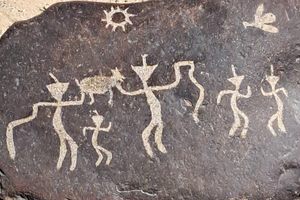
Under the scorching sun of southern Peru, on the fringes of the Atacama Desert, lie the Miculla Petroglyphs, a collection of ancient rock carvings whose origin remains a mystery. Preserved by both the dry climate and isolated location, the petroglyphs depict striking scenes: human figures engaged in dances or ceremonies; people hunting animals; and representations of animals, plants, and geometric patterns.
Scholars continue to debate who carved the stones and when. The presence of zigzag patterns alongside human figures suggests a lineage with Toro Muerto, a massive collection of over 6,000 petroglyphs found in the neighboring Arequipa region. Other researchers link the carvings to the Tiwanaku culture and the Inca empire, supported by the discovery of ceramics from these civilizations in the area. Additional candidates include the cultures of Colla, Chiribaya, or even the Chinchorro, an ancient coastal culture from northern Chile.
The dating of the petroglyphs is just as uncertain. Some estimates place them as early as 4,500 BCE, while more conservative estimates date the petroglyphs from 500 to 1500 AD, just before the arrival of the Spanish. It seems the only consensus among researchers is that the Miculla petroglyphs were carved by different cultural groups over various chronological periods.
Today, a selection of the petroglyphs can be visited at a small interpretation center located 22 kilometers (about 14 miles) to the northeast of the Peruvian city of Tacna, along a quiet highway that heads toward the triple frontier between Peru, Bolivia, and Chile. Adjacent to the observation center, a wooden suspension bridge leads to a couple of scenic viewpoints, inviting visitors to contemplate the silent, surrounding desert.
0 comments:
Post a Comment